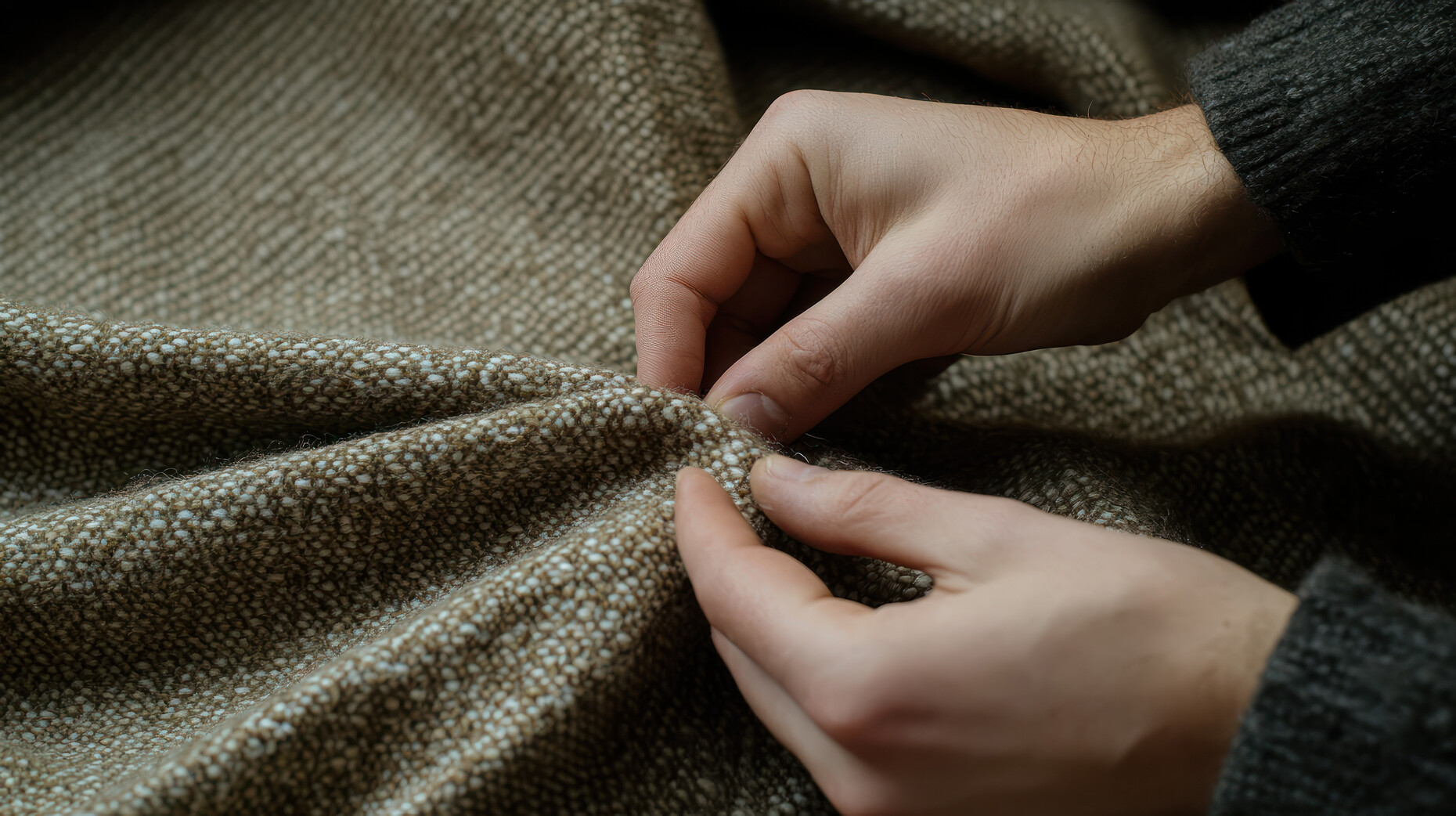Featured
With all senses
Anna Moldenhauer: Lesley, together with design researcher and textile designer Dr Anke Jakob, you published the scientific article ‘Sensory Design for Dementia Care – The Benefits of Textiles’. What was your approach to this topic?
Prof Lesley Collier: I am an occupational therapist and have always been interested in working with people who have very severe cognitive impairments. Together with a psychologist I was working with, I looked for ways to better reach people affected by dementia. There are sensory approaches for children with learning difficulties and we looked into the extent to which these would also be helpful for adults. The result is a room in a hospital that is based on the principles of a sensory environment, but designed to be more age-appropriate. People with dementia should feel safe in this environment and enjoy interacting with it. To achieve this, we tried out different objects – in the area of textiles, for example, optical fibres, cushions, blankets and covers for the armrests of chairs. These activate different tactile sensations. A few years later, Dr Anke Jakob contacted me with the question of whether we could apply the principles more systematically. That's how we started our research.
What were the first results?
Prof Lesley Collier: That people with dementia communicated more and their mood improved thanks to the sensory environment. We also involved relatives to create individualised sensory experiences – such as rough fabrics for a man who used to work as a carpenter. The haptics reminded him of his profession. So we thought a lot about people's past experiences of handling fabrics and textiles and developed a sensory toolbox to meet the need for sensory input. The different haptics of textiles, be it fur elements or elements such as buttons, tassels and sequins, encourage more interaction and exploration. We therefore looked at all kinds of accessories that can be attached to fabrics. The aim was to create both stimulating and calm areas so that people can choose the level of stimulation they want.
There are different stages of dementia, to what extent have you been able to research the influence of textiles in relation to each?
Prof Lesley Collier: Our research was focused on severe impairment, which can be a late stage of dementia but also severe learning disability or brain impairment following a head injury. We realised that the more severe the condition, the more singular the stimulus must be. A healthy brain can process different levels of stimulation at the same time, a diseased brain needs a clear focus to process the sensory stimulus. I would therefore say that it is not necessarily the type of substance that matters, but the complexity of the stimulus that it offers.
What underlies the processing of sensory stimuli in the brain?
Prof Lesley Collier: The beauty of our senses is that we don't have to think about them. That's why they also work well for people with cognitive impairments. Our senses are activated without us consciously thinking about them. But of course we can't be constantly bombarded with sensory impressions, because our brain wouldn't be able to cope with that. That's why we have the ability to filter the stimuli. We have a system in our brain stem called the reticular formation, which is a bit like a game controller in a video game. When we are highly stressed (the game control turned up), we may like to seek out low-stimulus environments to reduce stimulation. People with dementia, on the other hand, are no longer able to filter the information they receive. The level of stimulation must therefore be reduced and controlled from the outside so that they can process it.
In addition to the feel of the textiles, the sensory response also includes the smell, such as that of sheep's wool, and the sound, such as fabrics that crackle. Have you taken this into account?
Prof Lesley Collier: Absolutely. There are many variations, each fabric has its own character in feel, smell and sound, from leather to wool. There are also fabrics that are embedded in a fragrance, like a fabric softener that the person used to like. It's also about how we present textiles: A silky scarf invites you to want to wear it on your body, as do cords that can be threaded and knotted. The sensory systems are addressed through interaction with the textiles.
Have intelligent textiles also been investigated?
Prof. Lesley Collier: These have not yet been designed for our project, but I think fabrics with optical fibres would be particularly interesting. A weighted fabric also presses on the skin and has a calming effect, similar to a hug. This is described as deep proprioception.
How should rooms for people with dementia ideally be furnished with textiles?
Prof Lesley Collier: I prefer to work with the idea of a sensory toolbox, as this can be used flexibly for any environment. It starts with a sensory analysis of the individual that shows which senses the individual reacts to the most and how they process sensory information. Do they need a variety of sensory stimuli or do they dislike certain sensory impressions? The individual's past also plays a role, what profession did they have? What activities did they used to enjoy doing? Which textiles could evoke a memory?
As part of your research, you examined large number of care homes and found major differences in terms of the textiles used. The rooms designed by Sari Hedman in Finland, for example, were furnished with lots of textiles in neutral colours, whereas in the UK, fewer textiles were used, but there were more stimuli in the lighting. Is there training for carers on the extent to which sensory technology and textiles can be a therapeutic method?
Prof Lesley Collier: In my experience, Europe is ahead in this area. In the UK, it is often the quick fix that counts, such as a medication or technical assistance. However, this is not always the best approach. There are training courses are available to help guide carers, some of which I organise for companies myself. Sensory technology is now also part of the curriculum in occupational therapy training in the UK. However, sensory rooms are subject to numerous regulations, for example with regard to health and safety policies. Fabrics are removed for fear of infection and plastic is used instead. Smaller objects are out of the question as there is a concern that someone could choke on them. In the UK, I think the health and safety issue has got rather out of hand, which is very regrettable as sensory opportunities are limited.
”The different haptics of textiles, be it fur elements or elements such as buttons, tassels and sequins, encourage more interaction and exploration.“
Before you switched to an academic career, you worked for many years as an occupational therapist with people with dementia - what did you learn about sensory perception and textiles during this time?
Prof Lesley Collier: Working with my colleague in psychology, we realised that we needed different approaches at different times of the day. During the day, the sensory system should be stimulating for the patients, towards the evening and at night it should be calming. With this in mind, we also worked with aromas such as lemon and citrus with fast music with a tempo of 70 bars or more. This led to increase levels of arousal and alertness. In the evening we moved toward softer aromas such as lavender and slower music tempo. We chose soft fabrics for the textiles. Over the course of the day, we then observed how the people reacted to the stimuli, how active they were. The result: they were calmer, more balanced than before, even in the critical phase towards the evening, when people with dementia usually become restless. At the same time, we asked the relatives to report on the mood and behaviour of the patients without telling them in advance that they had received sensory therapy. We received confirmation through this channel, because according to the families, the patients were generally calmer. At this point, I decided to switch to research in order to be able to look at the effects of sensory therapy from other angles.
Could your research on the effect of sensor technology also be applied to workplace equipment?
Prof Lesley Collier: Yes, that would be possible. I have already made my first forays in this direction, be it for workplaces on earth or for the sensory deprivation of astronauts in space by the Space Development Organisation. Research into sensory technology not only concerns the treatment of illness, but also how we lead our lives. In everyday life, we are constantly surrounded by stimuli and also seek them out ourselves, such as in the form of the smartphone that we regularly check. Stimulation can be a drug. Our stress levels remain constantly high, the nervous system is constantly on alert and that is tiring. If you know about the great effect of sensory impressions, you can create them in a targeted way. It's not just about illness, but about how we live our lives. Some companies are already putting this into practice, creating green work areas, cosy rooms with sofas for communication and using textiles to separate quiet and lively zones. They have recognised that people work more effectively when the working environment is sensory diverse and there are low-stimulus areas. This also includes the lighting, the quality of the swivel chairs and the noise level. In short, it's all about the senses and movement.
How would you like textile trade fairs to take up research into sensory technology?
Prof Lesley Collier: For me, the realisation that information is primarily received through the senses is central. Seeing, hearing, feeling, tasting, smelling and moving are essential for our existence. If we want to influence people's mood and health, design should take sensory findings into account. Textiles influence the acoustics and feel of a room. For example, I have a leather inlay on my desk, which makes working on it particularly pleasant thanks to the feel.
What are you currently working on?
Prof Lesley Collier: I'm currently conducting a study with the University of Exeter in the UK, looking at treatment approaches for people with delirium. These people don't necessarily have a diagnosis of dementia before they come into hospital, but they may have had an infection and that affects their cognitive abilities. And the problem is that there is no specific treatment for delerium. So we offer a treatment approach that has both a sensory and a physical elements to rehabilitate the individual. So we work with physiotherapists to try and stimulate the brain while they're in the acute hospital setting then continue the therapy at home. The effects of delirium can be improved, but not with simple medication, it needs the right therapy and it doesn't have to be expensive. Unfortunately, patients are often transferred directly to a nursing home rather than being offered therapy.








